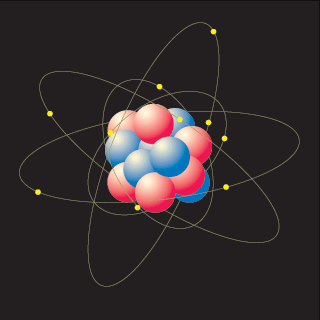
The Greek philosopher Democritus (ca. 460–ca. 370 B.C.E.) was partially right: matter does consist of atoms. But he would have been fascinated to know that the story doesn’t end there. Atoms can be further broken down into electrons, protons, and neutrons, and the latter two are made of even smaller things called quarks.
Electrons carry a negative electric charge, and protons a positive charge. Neutrons have a mass almost equal to a proton, but as their name implies, neutrons are neutral, with no positive or negative charge. Charged particles (like protons and electrons) that are not moving are surrounded by what we call an electric field; those in motion produce electromagnetic radiation.
James Clerk Maxwell (1831–1879) first explored what would happen if such a charged particle were to oscillate, or move quickly back and forth. He showed that a moving charged particle created a disturbance that traveled through space—without the need for any medium. Particles in space are getting banged around all the time. Atoms collide, electrons are accelerated by magnetic fields, and each time they move, they pull their fields along with them, sending “electromagnetic” ripples out into space.
In short, information about the particle’s motion is transmitted through space by a changing electric and magnetic field. But a field is not a substance. It is a way in which forces can be transmitted over great distances without any physical connection between the two places. The force of gravity, which we have discussed, can also be thought of as a field.
Let’s turn to a specific example: A star is made up of innumerable atoms, most of
which at unimaginably hot stellar temperatures are broken into innumerable charged
particles. A star produces a great deal of energy (by nuclear fusion. This energy causes particles to be in constant motion. In motion, the charged particles are the center points of electromagnetic waves (disturbances in the electromagnetic field) that move off in all directions. A small fraction of these waves reaches the surface of the earth, where they encounter other charged particles. Protons and electrons in our eyes, for instance, oscillate in response to the fluctuations in the electric field. As a result, we perceive light: an image of the star. If we happened to have, say, the right kind of infrared-detecting equipment with us, electrons if that equipment would respond to a different wavelength of vibrations originating from the same star.
Similarly, if we were equipped with sufficiently sensitive radio equipment, we might pick up a response to yet another set of proton and electron vibrations.
Remember, it is not that the star’s electrons and protons have traveled to Earth, but that the wave they generated so far away have excited other electrons and protons here. Call it an interstellar handshake.

No comments:
Post a Comment